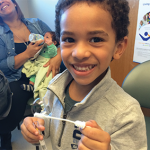WASHINGTON, D.C.—Children in pain—as a result of rheumatic diseases or other causes—is a whole different ballgame than adults in pain in terms of how it’s experienced, how it’s related to others, and the effects of feeling that pain, an expert said at a session titled, “Past, Present and Future Regulatory Perspectives on Analgesics,” at the 2012 ACR/ARHP Annual Meeting, held here November 9–14.
Mark Connelly, PhD, a clinical psychologist and acting director of integrative pain management at Children’s Mercy Hospital in Kansas City, said that, until the 1970s, it was widely believed that young children didn’t experience pain, and it might not be surprising that myths on the subject still persist. For instance, outdated notions persist that children can “get used to” pain more easily or can simply tell adults when they’re in pain.
Communicating Pain
Dr. Connelly said children in pain might communicate their pain in different ways than adults, such as by saying they don’t feel well or by clinging to parents. “If you see pain from an adult lens and apply that lens to pediatrics, you will have outcomes that are misleading,” he said.
The idea that children tolerate discomfort better than adults is not correct, he said—in fact, the reverse seems to be true. “Young children actually are more likely to become sensitized to pain—in other words, experience more pain, in some ways—because they have not yet fully developed the built-in ability to modulate or downregulate the pain as effectively as older kids and adults,” Dr. Connelly said.
Early experiences of pain can have big implications for later in life, he said. “There might be things that happen in early childhood with repeated painful stimulations that ultimately determine which kids might go on to develop chronic widespread pain,” he said.
The overarching idea stemming from pediatric pain research into pain medicine is that, hypothetically, there’s a “normal” pathway from childhood to adulthood when it comes to experiencing pain, and that early experiences might jolt someone off that course. For some children, one bump might be all that it takes; for others, a series of bumps over time might knock them into “an entirely different trajectory into adulthood,” Dr. Connelly said.
Pain from Childhood to Adulthood
There is some indication that pain experienced as a child can lead to chronic widespread pain as an adult. In one Danish study of 650 people, lower back pain in 14-year-old children predicted lower back pain, disability, and hospitalization 25 years later.1

